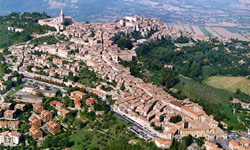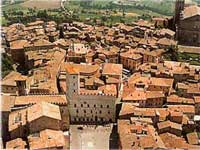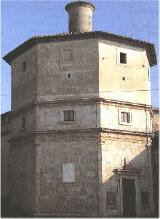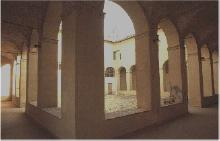TODI:
 In 2700 BC the Umbrian founded the city of Todi. Its original name was "Tuderte", meaning "border". From the 3rd century BC, the Etruscan and Roman peoples succeeded leaving numerous evidences, such as the Roman "Nicchioni" of Piazza del Mercato Vecchio, in origin, probably part of a Basilica. In 88 BC, Marco Crasso undressed the city of his property, which, after the fall of the Roman Empire, was plundered several times. The figure of the holy Bishop Fortunato goes back to this period and he became the protector of the city. In the Middle Ages, Todi was an enemy of neighboring Orvieto. In the 12th century it became a free municipality, inaugurating a very lucky period, in which the city was enriched with valuable monuments, including the Capitano Palace, the Palace of the Prior, Duomo and the Church of San Fortunato. In 1236 AC Jacopone da Todi was born, the most famous citizen of Todi and one of the first Italian dialect poets. In 1500, after a long period of decadence, the city benefited from the artistic and innovative push of the Renaissance era; the Temple of Consolation is an example. This artistic impulse greatly contributed to Bishop Angelo Cesi, who made numerous works of art.
In 2700 BC the Umbrian founded the city of Todi. Its original name was "Tuderte", meaning "border". From the 3rd century BC, the Etruscan and Roman peoples succeeded leaving numerous evidences, such as the Roman "Nicchioni" of Piazza del Mercato Vecchio, in origin, probably part of a Basilica. In 88 BC, Marco Crasso undressed the city of his property, which, after the fall of the Roman Empire, was plundered several times. The figure of the holy Bishop Fortunato goes back to this period and he became the protector of the city. In the Middle Ages, Todi was an enemy of neighboring Orvieto. In the 12th century it became a free municipality, inaugurating a very lucky period, in which the city was enriched with valuable monuments, including the Capitano Palace, the Palace of the Prior, Duomo and the Church of San Fortunato. In 1236 AC Jacopone da Todi was born, the most famous citizen of Todi and one of the first Italian dialect poets. In 1500, after a long period of decadence, the city benefited from the artistic and innovative push of the Renaissance era; the Temple of Consolation is an example. This artistic impulse greatly contributed to Bishop Angelo Cesi, who made numerous works of art.
 Things to visit in Todi
Things to visit in Todi
- Piazza del Popolo with the Palazzo dei Priori
- Gothic Church of San Fortunato
- November IV square with the ruins of the Rock
- Church of Santa Maria della Consolazione
- Romanesque Church of Sant'Ilario
- Scarnabecco da Bologna sources, Podestà di Todi
- The Roman Opera of the Nicchioni
- Cathedral of the XII-XVI century
- Etruscan-Roman Museum
- The Pinacoteca
MASSA MARTANA:
 Massa Martana is in the center of Umbria, between the capitals of the provinces of Perugia and Terni; it is enclosed by almost intact walls. The first settlements dating back to the construction of Via Flaminia, around 220 BC. The Roman presence is witnessed by the Ponte Fonnaia, a road construction of the 3rd century BC. Nearby there are the Christian Catacombs, the only one that has been discovered so far in Umbria. The territory is characterized by numerous forests, formed by Mediterranean scrub and the Martani Mountains, whose highest peaks exceed 1000 meters.
Massa Martana is in the center of Umbria, between the capitals of the provinces of Perugia and Terni; it is enclosed by almost intact walls. The first settlements dating back to the construction of Via Flaminia, around 220 BC. The Roman presence is witnessed by the Ponte Fonnaia, a road construction of the 3rd century BC. Nearby there are the Christian Catacombs, the only one that has been discovered so far in Umbria. The territory is characterized by numerous forests, formed by Mediterranean scrub and the Martani Mountains, whose highest peaks exceed 1000 meters.
 The cool climate and the proximity of the most famous historic-artistic centers, easily accessible by a good road network, give it a privileged role as a summer residence.
The cool climate and the proximity of the most famous historic-artistic centers, easily accessible by a good road network, give it a privileged role as a summer residence.
The city offers to nature lovers many possibilities, for example interesting and healthy hiking in the extensive and intact evergreen Aleppo holm and pine forests, where picturesque castles still preserve many of their original medieval architectures.
 Things to visit in Massa Martana
Things to visit in Massa Martana
- Church of Santa Maria in Pantano, (7th and 8th centuries)
- Abbey of San Faustino, built on the ruins of an ancient Roman villa, recently restored
- Abbey of SS. Fidenzio and Terenzio, dating back to the 11th century
- Abbeys of Santa Maria in Viepri (around 1150 BC)
- Church of Santa Maria della Pace (XVI - XVII sec.)
Every first Sunday of May, the procession at the Sanctuary of Madonna del Fosco (Castagnola, Giano dell'Umbria) is a very popular event. It is a pilgrimage of 20 km, which starts from the parishes of Massa Martana and Viepri and reaches to the sanctuary of the Madonna del Fosco; the procession follows some teams that support the statues of the Saints of the country on the shoulders.
COLLEVALENZA:
 The origins of the village are uncertain. It is thought that the name “Collevalenza” (also said “Colvalenza”) comes from the temple dedicated to Giunone Valentia, who stood in the place of the present castle. Faithful to the Ghibellines of the Chiaravalle family, it was long controversial by the opposing factions. In 1377 AD, the population was heavily oppressed and the castle was largely destroyed by the Guelph Catalano degli Atti. In 1424 AD, the castle was rebuilt and today it is still possible to admire the fifteenth towers and gothic walls with two openings. The center of the city, still furnished with medieval walls, owes its fame to the Shrine of Amore Misericordioso of Madre Speranza. The religious buildings of the sanctuary are one of the most significant expressions of sacred architecture of the second half of the twentieth century; it is an imposing complex with modern receptive structures embedded in a series of buildings located on the slopes of a hill. The central nucleus consists of the Great Church, consecrated in 1965 BC, by the Spanish architect Julio Lafuente, and by the chapel of Amore Misericordioso wanted by Madre Speranza in 1955 AD. Madre Speranza Alhama, in addition to several prodigious phenomena such as the transmutation of water in oil, has been the protagonist in the life of bilocation phenomena. Stigmatized, she often exuded blood. Memorable is the episode that took place in 1960, when, being the land of Collevalenza without water, relying on God (her "engineer"), she pointed to the stick where it was to proceed with the drilling to find the water that would renew Lourdes' wonders. After the breakup of numerous drills (according to mysticism caused by the Demon), the aquifers were found that Madre Speranza called "the relief of the body to find God." Only in 1998 there were almost 800 cases of healing.
The origins of the village are uncertain. It is thought that the name “Collevalenza” (also said “Colvalenza”) comes from the temple dedicated to Giunone Valentia, who stood in the place of the present castle. Faithful to the Ghibellines of the Chiaravalle family, it was long controversial by the opposing factions. In 1377 AD, the population was heavily oppressed and the castle was largely destroyed by the Guelph Catalano degli Atti. In 1424 AD, the castle was rebuilt and today it is still possible to admire the fifteenth towers and gothic walls with two openings. The center of the city, still furnished with medieval walls, owes its fame to the Shrine of Amore Misericordioso of Madre Speranza. The religious buildings of the sanctuary are one of the most significant expressions of sacred architecture of the second half of the twentieth century; it is an imposing complex with modern receptive structures embedded in a series of buildings located on the slopes of a hill. The central nucleus consists of the Great Church, consecrated in 1965 BC, by the Spanish architect Julio Lafuente, and by the chapel of Amore Misericordioso wanted by Madre Speranza in 1955 AD. Madre Speranza Alhama, in addition to several prodigious phenomena such as the transmutation of water in oil, has been the protagonist in the life of bilocation phenomena. Stigmatized, she often exuded blood. Memorable is the episode that took place in 1960, when, being the land of Collevalenza without water, relying on God (her "engineer"), she pointed to the stick where it was to proceed with the drilling to find the water that would renew Lourdes' wonders. After the breakup of numerous drills (according to mysticism caused by the Demon), the aquifers were found that Madre Speranza called "the relief of the body to find God." Only in 1998 there were almost 800 cases of healing.
Things to visit in Collevalenza
- Shrine of Amore Misericordioso
- The Holy Door of the Jubilee
- The Well of Amore Misericordioso
- Pools of the Shrines of the Amore Misericordioso
Pools of the Amore Misericordioso Shrine are known all over the world, and besides visiting them, it is also possible to immerse themselves in the Waters. According to tradition, Madre Speranza said, "By means of this water, wonders will be renewed, that is, they will be healing from severe infirmities, even incurable. It is among these diseases that human science can not cure, she has specifically named paralysis, cancer and leukemia. In this sense, the Water of the Shrine must be considered as a tool of Grace and an instrument of the Lord's mercy. "